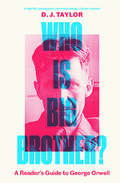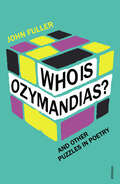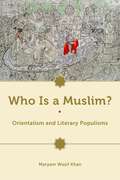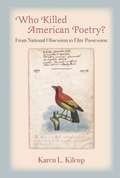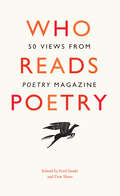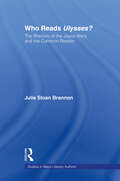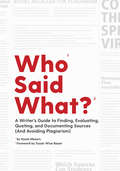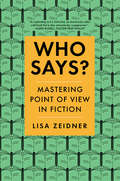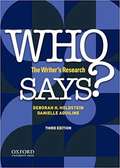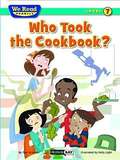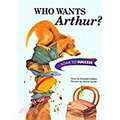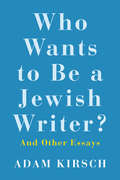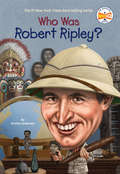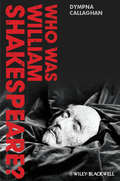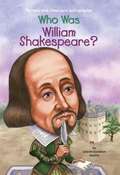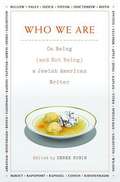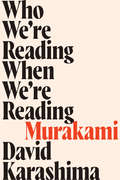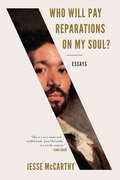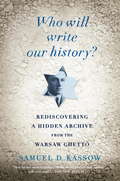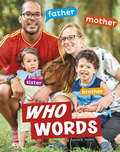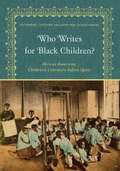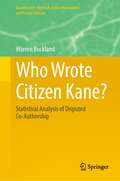- Table View
- List View
Who Is Big Brother?: A Reader's Guide to George Orwell
by D. J. TaylorA spirited and essential companion to Orwell and his works, covering all the novels and major essays An intellectual who hated intellectuals, a socialist who didn&’t trust the state—our foremost political essayist and author of Animal Farm and Nineteen Eighty-Four was a man of stark, puzzling contradictions. Knowing Orwell&’s life and reading Orwell&’s works produces just as many questions as it answers. Celebrated Orwell biographer D. J. Taylor guides fans and new readers alike through the many twists and turns of Orwell&’s books, life and thought. As a writer he intended his works to be transparent and instantly accessible, yet they are also full of secrets and surprises, tantalising private histories, and psychological quirks. From his conflicted relationship with religion to his competing anti-imperialism and fascination with empire, Who Is Big Brother? delves into the complex development of this essential yet enigmatic voice. Taylor leads us through Orwell&’s principal writings and complex life—crafting an illuminating guide to one of the most enduringly relevant writers in the English language.
Who Is Gus? (Seeing Stars Decoding Workbook #3)
by Nanci BellSeeing Stars® Decoding Workbooks are supplementary to the Seeing Stars® program and are designed to develop the student's ability to dual code--integrate imagery and language--for phonological processing, sight words, oral vocabulary, and reading comprehension. The goal is to develop decoding skills and at the same time stimulate symbol imagery as a primary sensory-cognitive function necessary for monitoring, self-correction, and fluency in the reading and spelling tasks.
Who Is Ozymandias?: And other Puzzles in Poetry
by John FullerPart of the pleasure of poetry is unravelling the mysteries and difficulties it contains and solving the puzzles that lie within. Who, for instance, is Ozymandias? What is the Snark? Who is the Emperor of Ice-Cream? Or indeed, who is 'you' in a poem? In this perceptive and playful new book, acclaimed poet John Fuller looks at some of our greatest poems and considers the number of individual puzzles at their heart, casting light on how we should approach these conundrums as readers. From riddling to double entendres, mysterious titles to red herrings, Fuller unpicks the puzzles in works that range from Browning to Bishop, Empson to Eliot, Shelley to Stevens, to help us reach the rewards and revelations that lie at the centre of some of our best-loved poems.
Who Is a Muslim?: Orientalism and Literary Populisms
by Maryam Wasif KhanWho Is a Muslim? argues that modern Urdu literature, from its inception in colonial institutions such as Fort William College, Calcutta, to its dominant iterations in contemporary Pakistan—popular novels, short stories, television serials—is formed around a question that is and historically has been at the core of early modern and modern Western literatures. The question “Who is a Muslim?,” a constant concern within eighteenth-century literary and scholarly orientalist texts, the English oriental tale chief among them, takes on new and dangerous meanings once it travels to the North-Indian colony, and later to the newly formed Pakistan. A literary-historical study spanning some three centuries, this book argues that the idea of an Urdu canon, far from secular or progressive, has been shaped as the authority designate around the intertwined questions of piety, national identity, and citizenship.
Who Killed American Poetry?: From National Obsession to Elite Possession
by Karen L. KilcupThroughout the 19th century, American poetry was a profoundly populist literary form. It circulated in New England magazines and Southern newspapers; it was read aloud in taverns, homes, and schools across the country. Antebellum reviewers envisioned poetry as the touchstone democratic genre, and their Civil War–era counterparts celebrated its motivating power, singing poems on battlefields. Following the war, however, as criticism grew more professionalized and American literature emerged as an academic subject, reviewers increasingly elevated difficult, dispassionate writing and elite readers over their supposedly common counterparts, thereby separating “authentic” poetry for intellectuals from “popular” poetry for everyone else.\ Conceptually and methodologically unique among studies of 19th-century American poetry, Who Killed American Poetry? not only charts changing attitudes toward American poetry, but also applies these ideas to the work of representative individual poets. Closely analyzing hundreds of reviews and critical essays, Karen L. Kilcup tracks the century’s developing aesthetic standards and highlights the different criteria reviewers used to assess poetry based on poets’ class, gender, ethnicity, and location. She shows that, as early as the 1820s, critics began to marginalize some kinds of emotional American poetry, a shift many scholars have attributed primarily to the late-century emergence of affectively restrained modernist ideals. Mapping this literary critical history enables us to more readily apprehend poetry’s status in American culture—both in the past and present—and encourages us to scrutinize the standards of academic criticism that underwrite contemporary aesthetics and continue to constrain poetry’s appeal. Who American Killed Poetry? enlarges our understanding of American culture over the past two hundred years and will interest scholars in literary studies, historical poetics, American studies, gender studies, canon criticism, genre studies, the history of criticism, and affect studies. It will also appeal to poetry readers and those who enjoy reading about American cultural history.
Who Killed Shakespeare: What's Happened to English Since the Radical Sixties
by Patrick BrantlingerFirst published in 2001. Routledge is an imprint of Taylor & Francis, an informa company.
Who Me? The Autobiography of Betty MacDonald
by Betty MacdonaldHer first husband wanted a ranch. He found one out in the middle of nowhere! He built the barn before the house and expected his new bride to raise baby chicks in the kitchen. (For more details, read "The Egg and I.") When the whole ranch experience got to be too much, MacDonald took her two girls and moved back home, where she worked at a variety of jobs, which her sister Mary found, proving the older sister's philosophy that "Anybody Can Do Anything," at least if their name is Betty MacDonald. And it was one of the office jobs, which caused the worst trouble--tuberculosis--and a stay in a sanatorium. (Those nine months are chronicled in "The Plague and I.") Eventually, Betty meets another man, falls in love, and moves (with her two girls) to an island. (For more details, read "Onions in the Stew.") Heartwarming and funny. All books mentioned in this synopsis are available from Bookshare.
Who Reads Poetry: 50 Views from “Poetry” Magazine
by Don Share Fred SasakiWho reads poetry? We know that poets do, but what about the rest of us? When and why do we turn to verse? Seeking the answer, Poetry magazine since 2005 has published a column called “The View From Here,” which has invited readers “from outside the world of poetry” to describe what has drawn them to poetry. Over the years, the incredibly diverse set of contributors have included philosophers, journalists, musicians, and artists, as well as doctors and soldiers, an iron-worker, an anthropologist, and an economist. This collection brings together fifty compelling pieces, which are in turns surprising, provocative, touching, and funny. In one essay, musician Neko Case calls poetry “a delicate, pretty lady with a candy exoskeleton on the outside of her crepe-paper dress.” In another, anthropologist Helen Fisher turns to poetry while researching the effects of love on the brain, “As other anthropologists have studied fossils, arrowheads, or pot shards to understand human thought, I studied poetry. . . . I wasn’t disappointed: everywhere poets have described the emotional fallout produced by the brain’s eruptions.” Even film critic Roger Ebert memorized the poetry of e. e. cummings, and the rapper Rhymefest attests here to the self-actualizing power of poems: “Words can create worlds, and I’ve discovered that poetry can not only be read but also lived out. My life is a poem.” Music critic Alex Ross tells us that he keeps a paperback of The Palm at the End of the Mind by Wallace Stevens on his desk next to other, more utilitarian books like a German dictionary, a King James Bible, and a Macintosh troubleshooting manual. Who Reads Poetry offers a truly unique and broad selection of perspectives and reflections, proving that poetry can be read by everyone. No matter what you’re seeking, you can find it within the lines of a poem.
Who Reads Ulysses?: The Common Reader and the Rhetoric of the Joyce Wars (Studies in Major Literary Authors #Vol. 19)
by Julie Sloan BrannonFirst published in 2003. Routledge is an imprint of Taylor & Francis, an informa company.
Who Said What? (and Avoiding Plagiarism): A Writer's Guide To Finding, Quoting, And Documenting Sources (and Avoiding Plagiarism)
by Kayla MeyersA thorough, accessible guide to research, citation, and source evaluation, designed to assist students growing up in an era of social media, fake news, alternative facts, and information overload. Is Yahoo Answers a good source for your History essay? How about InfoWars? How do you include another person’s ideas in your work without stealing them? Should you cite an Instagram post as a source, and if so, how do you do it? Who Said What? provides students from middle school through college (along with bloggers, writers, and others who need to write with accuracy and clarity) with a reliable, friendly guide through the often bewildering process of research, writing, and documentation. Drawing on years of teaching, research, and writing experience, Kayla Meyers teaches you how to evaluate the trustworthiness of a source, how to use it without stealing it, how to properly credit its creator, and why all of this even matters. With contemporary examples and the step-by-step explanations that made Susan Wise Bauer’s Writing With Skill series so popular, Who Said What? will become an essential resource for young writers.
Who Says?: Mastering Point Of View In Fiction
by Lisa ZeidnerA thorough, illuminating, and entertaining guide to crafting point of view, a fiction writer’s most essential choice. Who is telling the story to whom is the single most important question about any work of fiction; the answer is central to everything from style and tone to plot and pacing. Using hundreds of examples from Jane Austen to Chimamanda Ngozi Adichie, Leo Tolstoy to Stephen King, novelist and longtime MFA professor Lisa Zeidner dives deep into the points of view we are most familiar with—first and third person—and moves beyond to second-person narration, frame tales, and even animal points of view. Engaging and accessible, Who Says? presents any practicing writer with a new system for choosing a point of view, experimenting with how it determines the narrative, and applying these ideas to revision.
Who Says?: The Writer's Research
by Danielle Aquiline Deborah H. HoldsteinNow in a new edition, Who Says? The Writer's Research is an innovative and brief research guide focusing on information literacy. The text shows students not only how to do research but also why research is important. <p><p> Written for today's college student, Who Says? addresses contemporary research issues head on: <p><p> - What does it mean to conduct research in an age when we are bombarded by collaborative information through online media and databases like Wikipedia? - Who owns this information? How do we know? - As information circulates and changes, do the lines between audience and author blur? - How should these changes alter our expectations as readers and as writers? <p><p> By prompting students to think critically about matters of ownership and authority, Who Says? not only shows students how to find and incorporate credible sources in their writing, but also encourages students to synthesize their own ideas with the ideas of others, leading them to develop more confident and compelling voices as writers.
Who Took the Cookbook?
by Kelly Light Paul OrshoskiThe cook in the lunchroom usually serves great food, but now her cookbook and all her recipes are missing and her food is just awful! Students join in the hunt to find her missing cookbook in this fun story with a surprise ending. This humorous title offers engaging phonics practice and fun phonics games.
Who Wants to Be a Jewish Writer?: And Other Essays
by Adam KirschFrom one of today’s keenest critics comes a collection of essays on poetry, religion, and the connection between the two Adam Kirsch is one of today’s finest literary critics. This collection brings together his essays on poetry, religion, and the intersections between them, with a particular focus on Jewish literature. He explores the definition of Jewish literature, the relationship between poetry and politics, and the future of literary reputation in the age of the internet. Several essays look at the way Jewish writers such as Stefan Zweig and Isaac Deutscher, who coined the phrase “the non‑Jewish Jew,” have dealt with politics. Kirsch also examines questions of spirituality and morality in the writings of contemporary poets, including Christian Wiman, Kay Ryan, and Seamus Heaney. He closes by asking why so many American Jewish writers have resisted that category, inviting us to consider “Is there such a thing as Jewish literature?”
Who Was Robert Ripley? (Who was?)
by Nancy Harrison Kirsten Anderson Tim FoleyEnter a world of shrunken heads, mystic holy men, shriveled aliens, and bizarre relics in the delightfully odd tale of Robert Ripley. Born in California, Ripley began his career as a sports cartoonist. He went on to chronicle global records and oddities in his weekly column, Believe It Or Not! After publishing mogul William Randolph Hearst took an interest in the column, it became a syndicated global success. Ripley spent his life traveling to more than 200 countries in search of strange objects and interesting facts. His penchant for the peculiar launched an entertainment empire, and his collection of artifacts can be seen worldwide at his famous Odditoriums. Believe It Or Not!
Who Was William Shakespeare
by Dympna CallaghanA new study of Shakespeare's life and times, which illuminates our understanding and appreciation of his works.Combines an accessible fully historicised treatment of both the life and the plays, suited to both undergraduate and popular audiencesLooks at 24 of the most significant plays and the sonnets through the lens of various aspects of Shakespeare's life and historical environmentAddresses four of the most significant issues that shaped Shakespeare's career: education, religion, social status, and theatreExamines theatre as an institution and the literary environment of early modern LondonExplains and dispatches conspiracy theories about authorship
Who Was William Shakespeare?
by Celeste Davidson MannisThe beloved plays of Shakespeare are still produced everywhere, yet the life of the world's most famous playwright remains largely a mystery. Young Will left the town of Stratford to pursue theatre in London, where his work eventually thrived and made him a famous and wealthy man. Celeste Davidson Mannis puts together the pieces of Shakespeare's life and work for young readers.
Who We Are: On Being (and Not Being) A Jewish American Writer
by Derek RubinThis unprecedented collection brings together the major Jewish American writers of the past fifty years as they examine issues of identity and how they've made their work respond. E. L. Doctorow questions the very notion of the Jewish American writer, insisting that all great writing is secular and universal. Allegra Goodman embraces the categorization, arguing that it immediately binds her to her readers. Dara Horn, among the youngest of these writers, describes the tendency of Jewish writers to focus on anti-Semitism and advocates a more creative and positive way of telling the Jewish story. Thane Rosenbaum explains that as a child of Holocaust survivors, he was driven to write in an attempt to reimagine the tragic endings in Jewish history. Here are the stories of how these writers became who they are: Saul Bellow on his adolescence in Chicago, Grace Paley on her early love of Romantic poetry, Chaim Potok on being transformed by the work of Evelyn Waugh. Here, too, are Philip Roth, Cynthia Ozick, Erica Jong, Jonathon Rosen, Tova Mirvis, Pearl Abraham, Alan Lelchuk, Rebecca Goldstein, Nessa Rapoport, and many more. Spanning three generations of Jewish writing in America, these essays -- by turns nostalgic, comic, moving, and deeply provocative- constitute an invaluable investigation into the thinking and the work of some of America's most important writers.
Who We're Reading When We're Reading Murakami
by David KarashimaHow did a loner destined for a niche domestic audience become one of the most famous writers alive? A "fascinating" look at the "business of bringing a best-selling novelist to a global audience" (The Atlantic)―and a “rigorous” exploration of the role of translators and editors in the creation of literary culture (The Paris Review). Thirty years ago, when Haruki Murakami’s works were first being translated, they were part of a series of pocket-size English-learning guides released only in Japan. Today his books can be read in fifty languages and have won prizes and sold millions of copies globally. How did a loner destined for a niche domestic audience become one of the most famous writers alive? This book tells one key part of the story. Its cast includes an expat trained in art history who never intended to become a translator; a Chinese American ex-academic who never planned to work as an editor; and other publishing professionals in New York, London, and Tokyo who together introduced a pop-inflected, unexpected Japanese voice to the wider literary world. David Karashima synthesizes research, correspondence, and interviews with dozens of individuals—including Murakami himself—to examine how countless behind-the-scenes choices over the course of many years worked to build an internationally celebrated author’s persona and oeuvre. His careful look inside the making of the “Murakami Industry" uncovers larger questions: What role do translators and editors play in framing their writers’ texts? What does it mean to translate and edit “for a market”? How does Japanese culture get packaged and exported for the West?
Who Will Pay Reparations on My Soul?: Essays
by Jesse McCarthy"This is a very smart and soulful book. Jesse McCarthy is a terrific essayist." —Zadie Smith New York Times • "New Books to Watch For in March" A supremely talented young critic’s essays on race and culture, from Toni Morrison to trap, herald the arrival of a major new voice in American letters. Ranging from Ta-Nehisi Coates’s case for reparations to Toni Morrison’s revolutionary humanism to D’Angelo’s simmering blend of R&B and racial justice, Jesse McCarthy’s bracing essays investigate with virtuosic intensity the art, music, literature, and political stances that have defined the twenty-first century. Even as our world has suffered through successive upheavals, McCarthy contends, “something was happening in the world of culture: a surging and unprecedented visibility at every level of black art making.” Who Will Pay Reparations on My Soul? reckons with this resurgence, arguing for the central role of art and intellectual culture in an age of widening inequality and moral crisis. McCarthy reinvigorates the essay form as a space not only for argument but for experimental writing that mixes and chops the old ways into new ones. In “Notes on Trap,” he borrows a conceit from Susan Sontag to reveal the social and political significance of trap music, the drug-soaked strain of Southern hip-hop that, as he puts it, is “the funeral music that the Reagan Revolution deserves.” In “Back in the Day,” McCarthy, a black American raised in France, evokes his childhood in Paris through an elegiac account of French rap in the 1990s. In “The Master’s Tools,” the relationship between Spanish painter Diego Velázquez and his acolyte-slave, Juan de Pareja, becomes the lens through which Kehinde Wiley’s paintings are viewed, while “To Make a Poet Black” explores the hidden blackness of Sappho and the erotic power of Phillis Wheatley. Essays on John Edgar Wideman, Claudia Rankine, and Colson Whitehead survey the state of black letters. In his title essay, McCarthy takes on the question of reparations, arguing that true progress will not come until Americans remake their institutions in the service of true equality. As he asks, “What can reparations mean when the damage cannot be accounted for in the only system of accounting that a society recognizes?” For readers of Teju Cole’s Known and Strange Things and Mark Greif’s Against Everything, McCarthy’s essays portray a brilliant young critic at work, making sense of our disjointed times while seeking to transform our understanding of race and art, identity and representation.
Who Will Write Our History?: Rediscovering a Hidden Archive from the Warsaw Ghetto
by Samuel D. KassowIn 1940, in the Jewish ghetto of Nazi-occupied Warsaw, the Polish historian Emanuel Ringelblum established a clandestine scholarly organization called the Oyneg Shabes to record the experiences of the ghetto's inhabitants. For three years, members of the Oyneb Shabes worked in secret to chronicle the lives of hundereds of thousands as they suffered starvation, disease, and deportation by the Nazis. Shortly before the Warsaw ghetto was emptied and razed in 1943, the Oyneg Shabes buried thousands of documents from this massive archive in milk cans and tin boxes, ensuring that the voice and culture of a doomed people would outlast the efforts of their enemies to silence them. Impeccably researched and thoroughly compelling, Samuel D. Kassow's Who Will Write Our History? tells the tragic story of Ringelblum and his heroic determination to use historical scholarship to preserve the memory of a threatened people.From the Trade Paperback edition.
Who Words (Word Play)
by Carrie B. SheelyParents, sisters, brothers, friends, and teachers are just some of the people in children's lives. Bring these words about people to young learners, and watch their vocabularies grow! Words are carefully matched to engaging photos that will keep children captivated from beginning to end.
Who Writes for Black Children?: African American Children’s Literature before 1900
by Katharine Capshaw Anna Mae DuaneUntil recently, scholars believed that African American children&’s literature did not exist before 1900. Now, Who Writes for Black Children? opens the door to a rich archive of largely overlooked literature read by black children. This volume&’s combination of analytic essays, bibliographic materials, and primary texts offers alternative histories for early African American literary studies and children&’s literature studies.From poetry written by a slave for a plantation school to joyful &“death biographies&” of African Americans in the antebellum North to literature penned by African American children themselves, Who Writes for Black Children? presents compelling new definitions of both African American literature and children&’s literature. Editors Katharine Capshaw and Anna Mae Duane bring together a rich collection of essays that argue for children as an integral part of the nineteenth-century black community and offer alternative ways to look at the relationship between children and adults. Including two bibliographic essays that provide a list of texts for future research as well as an extensive selection of hard-to-find primary texts, Who Writes for Black Children? broadens our ideas of authorship, originality, identity, and political formations. In the process, the volume adds new texts to the canon of African American literature while providing a fresh perspective on our desire for the literary origin stories that create canons in the first place. Contributors: Karen Chandler, U of Louisville; Martha J. Cutter, U of Connecticut; LuElla D&’Amico, Whitworth U; Brigitte Fielder, U of Wisconsin–Madison; Eric Gardner, Saginaw Valley State U; Mary Niall Mitchell, U of New Orleans; Angela Sorby, Marquette U; Ivy Linton Stabell, Iona College; Valentina K. Tikoff, DePaul U; Laura Wasowicz; Courtney Weikle-Mills, U of Pittsburgh; Nazera Sadiq Wright, U of Kentucky.
Who Wrote Citizen Kane?: Statistical Analysis of Disputed Co-Authorship (Quantitative Methods in the Humanities and Social Sciences)
by Warren BucklandThis book offers a solution to one of film history’s major controversies: the long-running dispute over Orson Welles’ and Herman J. Mankiewicz’s contributions to the Citizen Kane screenplay. It establishes the vital importance of computing and statistics to solving previously intractable puzzles in the arts and humanities. Citizen Kane (1941) is one of the most acclaimed films in the history of cinema. For 50 years it topped the Sight & Sound film critics’ poll. Orson Welles directed the film and is credited with co-writing the screenplay with Herman J. Mankiewicz. But the co-writer credit generates furious disputes between those who argue Mankiewicz is the sole author of Citizen Kane and those who claim that Welles collaborated fully with its writing. The author employs computing and statistics to answer two questions: What are the distinguishing features of Welles’ and of Mankiewicz’s writing? And What did each contribute to the writing of the Citizen Kane screenplay? To answer these questions, the author bypasses opinions and impressions, and instead subjects the language of the Citizen Kane screenplay to a ‘forensic’ examination. Employing linguistics, basic statistical tests, plus computer technology and software, the author identifies the stylistic signature of each author – the combination of consistent and regular linguistic habits that make each author’s writing distinctive. This book replaces impressionistic discussions of Mankiewicz’s and Welles’ contributions to the Citizen Kane screenplay with a rigorous, experiment-driven statistical analysis. Earlier statistical studies of authorship have discovered that small, unassuming language features (such as punctuation, pronouns, and prepositions) in statistically significant quantities, constitute a screenwriter’s distinctive writing habits. Only with the extensive experimentation carried out in this volume, did the author decide Mankiewicz’s and Welles’ specific habits and their contributions to Citizen Kane.
